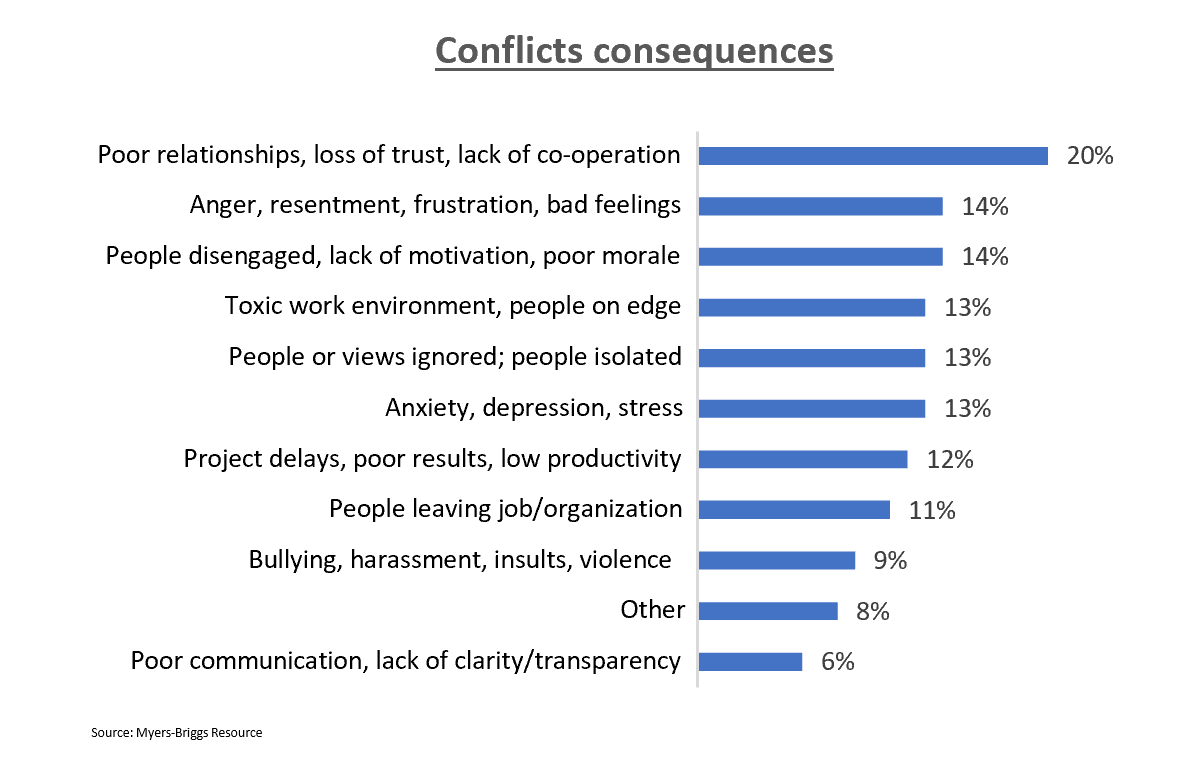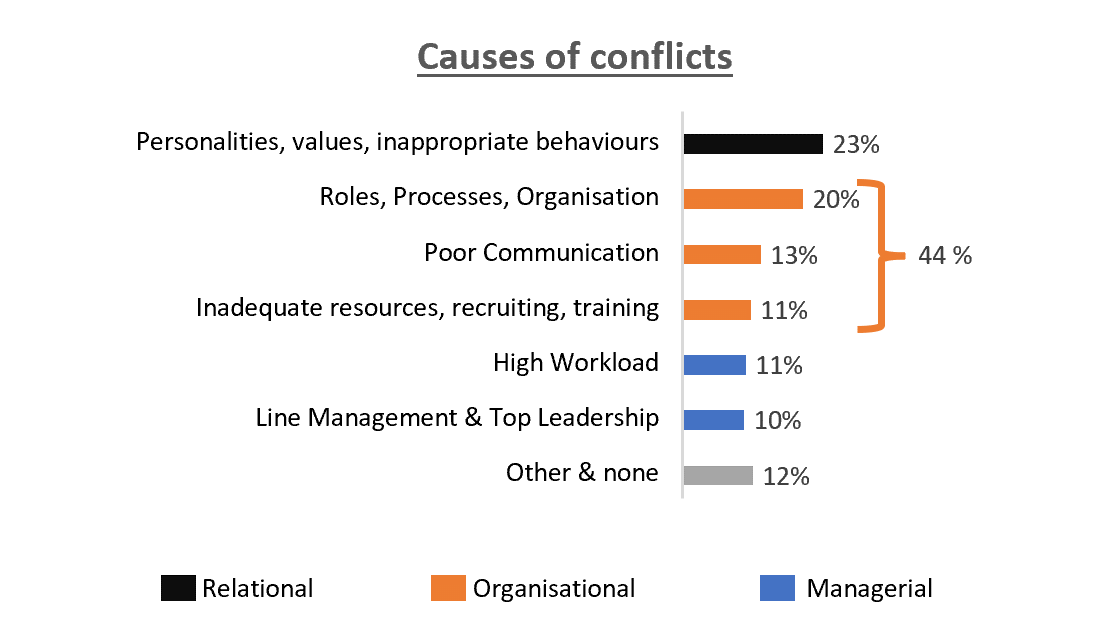Conflicts at work are costly, so let's deal with the causes, which aren't as personal as we think
Workplace conflicts lead to very high losses, not only financially but also in terms of employee well-being and effectiveness. However, very few managers are trained to prevent and manage conflicts in their teams. And most importantly, it is crucial to identify the real causes of conflicts because they are not as personal as one might think.
1. Workplace conflicts are common and have major negative impacts
Up to 85% of employees have been in a situation of conflict with a loss of up to 40% of their time
From 69% to 85% of employees occasionally find themselves in conflict at work, and from 25% to 38% of employees regularly experience it.Employees spend from 3 to 4.3 hours per week in conflicts. This time has doubled since 2008 (around 2.1 hours/week) and reached 4.3 hours by 2022.
The impact is even greater for managers (25% more time than non-managerial employees) because they also spend time mediating conflicts among their team members (up to 40% of their time). Employees in high-performing companies also spend more time in conflict situations (also 25% more).
Negative impacts on teamwork, individuals, and results
Workplace conflicts can have profound and costly repercussions for companies and their employees. The most significant impact is on team functioning, with poor relationships, loss of trust, and lack of cooperation (reported by 20% of survey respondents), exacerbated by a toxic environment (13%). Individuals experience negative emotions (14%), feel isolated (13%) with increased stress, and even a risk of depression.
Conflicts cause emotional and psychological problems that lead to an increase in sick days (from 9% to 22% of individuals according to studies).
11% of individuals in conflict situations indicate a desire to change jobs or even resign as a result of these conflicts. According to the Acas4 study, 5% actually resign. On the other hand, conflicts at work account for between 30 and 40% of the reasons for resignations8.
The negative impact on results and loss of productivity is cited by 12% of people in conflicts. Furthermore, the productivity loss caused by conflicts is estimated at 12% (Zipdo8),
The cost, in addition to the productivity loss, caused by conflicts at work in the United Kingdom in 2021 was estimated at £3000 / year per person involved in a conflict. This cost includes the costs of absenteeism, resignations, informal external resolution or mediation, formal and legal procedures4.
2. Managers must avoid being the cause of conflicts and better manage them
Figures show that managers can themselves be the source of conflicts (mentioned by 10% of employees in conflict), whether it's direct managers or top management.
Above all, they play an essential role in resolving workplace conflicts, as they resolve about 60% of conflicts. However, on average, they are not effective enough, mainly because they are not sufficiently trained:
- Among the surveyed managers, 31% believe they handle conflicts well. However, only 22% of non-managerial employees think their managers do a good job in resolving disagreements.
- 60% of employees have never received basic conflict resolution training in the workplace. 95% of those who have report that the training helped them positively manage workplace conflicts and seek mutually beneficial outcomes.
3. Well-managed workplace conflicts can have positive outcomes
76% of employees have seen benefits from workplace conflicts in a study conducted across multiple countries by CPP. This proportion is even higher when employees are trained in conflict management. . Indeed, this proportion is significantly higher in countries with a high rate of conflict training than in those with a low rate:- In Brazil, 84% of employees saw benefits for a training rate of 57%.
- In France, 30% of employees saw benefits for a training rate of 27%.
4. But it starts with identifying the true causes of conflicts
Like any problem, a conflict can only be resolved by addressing its root causes. However, this task is particularly challenging because it involves dealing with humans and all their emotional aspects.In fact, the results may appear counterintuitive and surprising. Indeed, we can draw the following conclusion:
Most causes of "interpersonal" conflict are not related to individuals, even though their initial visible manifestations may be.
Our analysisa of the 2022 study by Myers-Briggs (one of the few studies offering a fairly comprehensive list of causes to respondents) is illustrated in the graph below.

Relational / personal causesb occupy a significant place, accounting for 23% of the total. But the grouping of organizational categories is the leading cause of conflict. And causes directly related to management come very close to relational causes, at 21%.
These results may be surprising because most studies on the subject mainly mention individual causes. However, this is often because these studies ask questions focused on personal aspects. Or the categorization of different causes highlights the personal aspect, while organizational aspects are spread across several categories and not grouped together.
These results are also counterintuitive because, regardless of the original cause, a conflict is seen through mood swings among individuals. For example, if a role or process is not clear, several employees may duplicate activities, or none may perform them. This can lead to disputes among these employees. If these disputes are not resolved, and there is also an excessive workload, these disputes can turn into irritations... and a "clash of personalities".
If the root cause is not understood, people will remember the bad moods, personalities, etc. and may eventually try to address them. However, they will be addressing the symptoms of the problem, not its cause. While it may help individuals improve their behavior in response to these problems, there is a significant risk of conflicts resurfacing later (possibly with different people if the "treatment" involved changing individuals).
5. Conclusion
Workplace conflicts are costly for companies and deeply impact employees. Managers should receive better training because they play a significant role in conflict prevention and resolution. Well-trained managers can even turn conflicts into opportunities with positive effects for their organizations. However, to do this, they must first identify the root causes of conflicts, going beyond visible "mood" manifestations, to avoid treating symptoms unnecessarily.Notes:
a: 17 causes were proposed to respondents. To simplify the graph, we have already made some initial groupings and consolidated the numbers on a total basis of 100.
b: Organizational causes: causes related to processes, rules, organization, roles and responsibilities, performance management system. Managerial causes: behaviors and actions of managers. Personal causes: cultural or personality differences, inappropriate behaviors (insults, unpleasant remarks, violence, etc.)
Statistical sources:
a: 17 causes were proposed to respondents. To simplify the graph, we have already made some initial groupings and consolidated the numbers on a total basis of 100.
b: Organizational causes: causes related to processes, rules, organization, roles and responsibilities, performance management system. Managerial causes: behaviors and actions of managers. Personal causes: cultural or personality differences, inappropriate behaviors (insults, unpleasant remarks, violence, etc.)
Statistical sources:
- Common Workplace Conflicts by CSP Online
- OpinionWay 2021 Survey
- Myers-Briggs Resource (2023) by The Myers-Briggs Company
- Estimating the Costs of Workplace Conflict by Acas
- CPP Conflict Report
- Workplace Conflict Statistics by Pollack Peacebuilding
- CIPD Getting under the skin of conflict
- CIPD Zipdo :Workplace Conflict Statistics
Stay Informed
When you subscribe to the blog, we will send you an e-mail when there are new updates on the site so you wouldn't miss them.




Comments 1
Hey, your post really highlights the hidden complexities in workplace conflicts. It's shocking to see how these issues, often mislabeled as personal, can deeply affect both teams and results. 🤯
You're spot on about managers needing better training in conflict resolution. It's not just about calming the storm but understanding its origins. Organizational Network Analysis (ONA) can be a game-changer here, offering a clearer picture of underlying issues. 🕵️♂️
Have you seen instances where ONA directly helped in resolving such conflicts? 🤔